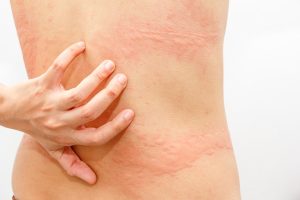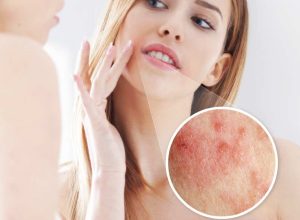Understanding Perioral Dermatitis Perioral dermatitis is a common skin condition that primarily affects the area around the mouth, including the lips, chin, and sometimes the cheeks and nose. It presents as redness, small bumps, and sometimes mild peeling or flaking. While the exact cause of perioral dermatitis is not fully understood, several factors may contribute
Understanding Perioral Dermatitis
Perioral dermatitis is a common skin condition that primarily affects the area around the mouth, including the lips, chin, and sometimes the cheeks and nose. It presents as redness, small bumps, and sometimes mild peeling or flaking. While the exact cause of perioral dermatitis is not fully understood, several factors may contribute to its development, including:
1. Environmental Triggers
Environmental factors such as harsh weather conditions, exposure to irritants like certain skincare products or cosmetics, and even stress can trigger or exacerbate perioral dermatitis.
2. Hormonal Changes
Hormonal fluctuations, particularly in women, can play a significant role in the onset of perioral dermatitis. This is why it’s not uncommon for women to experience flare-ups during pregnancy or menstruation.
3. Microbial Factors
Certain bacteria or yeast overgrowth on the skin’s surface may also contribute to the development of perioral dermatitis. This is why maintaining good skincare hygiene is essential in managing the condition.

Image by: yendex.com
Signs and Symptoms
Recognizing the signs and symptoms of perioral dermatitis is crucial for prompt diagnosis and treatment. Common manifestations of the condition include:
1. Redness and Inflammation
The affected area typically appears red and inflamed, with a distinct border around the mouth.
2. Small Bumps or Pustules
Clusters of small, acne-like bumps or pustules may develop, giving the skin a rough texture.
3. Mild Itching or Burning
Some individuals may experience mild itching or burning sensations in the affected area, although this is not always present.
4. Peeling or Flaking Skin
In more severe cases, the skin around the mouth may become dry, peeling, or flaking.

Image by: yendex.com
Treatment Options
Effective management of perioral dermatitis often involves a combination of skincare modifications, topical treatments, and in some cases, oral medications. Here are some common approaches to treating perioral dermatitis:
1. Skincare Adjustments
Avoiding potential triggers such as harsh cleansers, fragranced products, and certain cosmetics can help alleviate symptoms. Opt for gentle, non-comedogenic skincare products formulated for sensitive skin.
2. Topical Treatments
Topical medications containing ingredients like metronidazole, azelaic acid, or sulfur can help reduce inflammation and control bacterial or yeast overgrowth on the skin’s surface.
3. Oral Antibiotics
In cases of moderate to severe perioral dermatitis, oral antibiotics such as tetracycline or doxycycline may be prescribed to address underlying microbial factors.
4. Immunosuppressive Agents
For refractory cases or those resistant to conventional treatments, immunosuppressive agents like tacrolimus or pimecrolimus may be considered, although these should be used cautiously due to potential side effects. Explore More About (Ear Ringing Get Worse)

Image by: yendex.com
Preventive Measures
While managing perioral dermatitis is essential, taking preventive measures can also help reduce the likelihood of flare-ups and recurrence. Here are some tips to keep perioral dermatitis at bay:
1. Maintain a Consistent Skincare Routine
Establishing a gentle skincare routine and sticking to it can help maintain the skin barrier and prevent flare-ups.
2. Avoid Triggering Factors
Identify and avoid triggers such as harsh skincare products, spicy foods, and extreme weather conditions that may exacerbate symptoms.
3. Practice Stress Management
Stress can trigger hormonal fluctuations that may worsen perioral dermatitis. Incorporating stress-reducing activities such as yoga, meditation, or deep breathing exercises can help keep symptoms in check.
4. Follow a Balanced Diet
A well-balanced diet rich in fruits, vegetables, lean proteins, and whole grains can support overall skin health and reduce inflammation.

Image by: yandex.com
Topical Treatments for Perioral Dermatitis
| Treatment | Active Ingredient(s) | Mechanism of Action | Side Effects |
|---|---|---|---|
| Metronidazole | Metronidazole | Anti-inflammatory, anti-bacterial | Dryness, redness, irritation |
| Azelaic Acid | Azelaic acid | Anti-inflammatory, keratolytic | Mild stinging, itching |
| Sulfur | Sulfur | Antimicrobial, keratolytic | Skin irritation, odor |
Conclusion
Perioral dermatitis can be a challenging condition to manage, but with the right approach, it is possible to keep symptoms under control and maintain clear, healthy-looking skin. By understanding the triggers, recognizing the signs and symptoms, and adopting preventive measures, individuals can effectively manage perioral and minimize its impact on their daily lives.
Remember, consistency is key when it comes to skincare, and seeking professional guidance from a dermatologist can provide personalized treatment recommendations tailored to individual needs. With dedication and patience, managing perioral is achievable, allowing individuals to regain confidence and comfort in their skin.
















